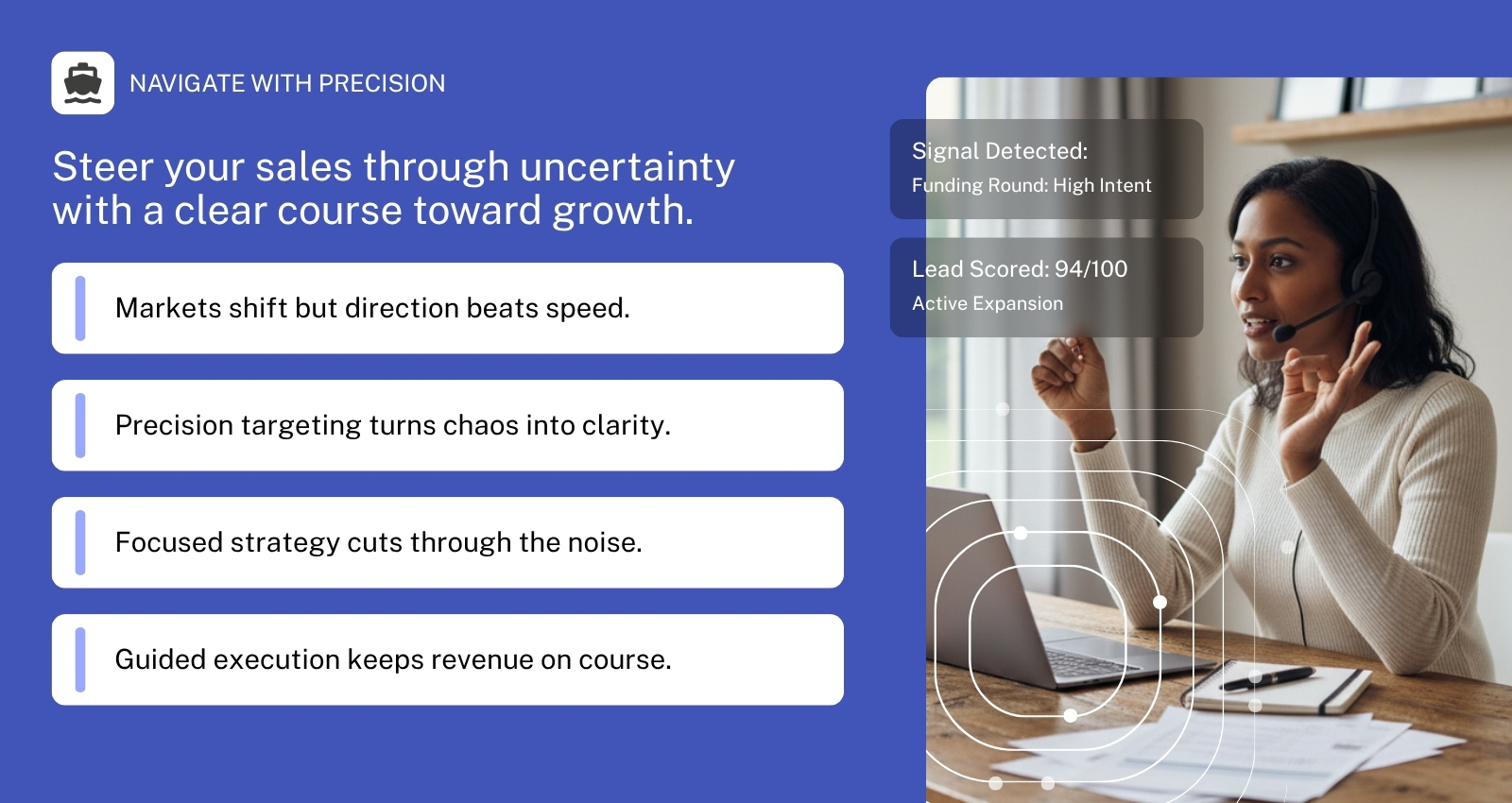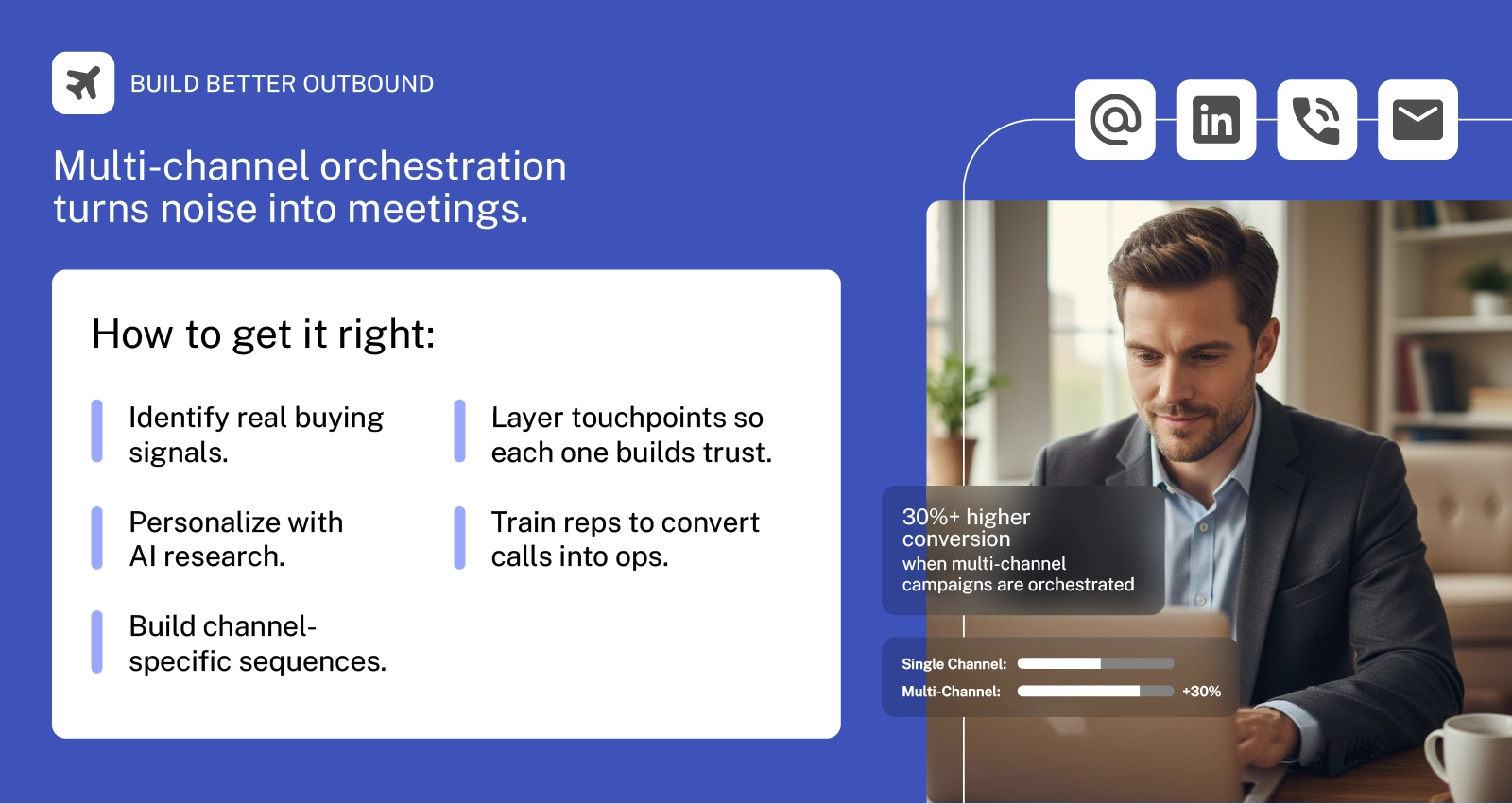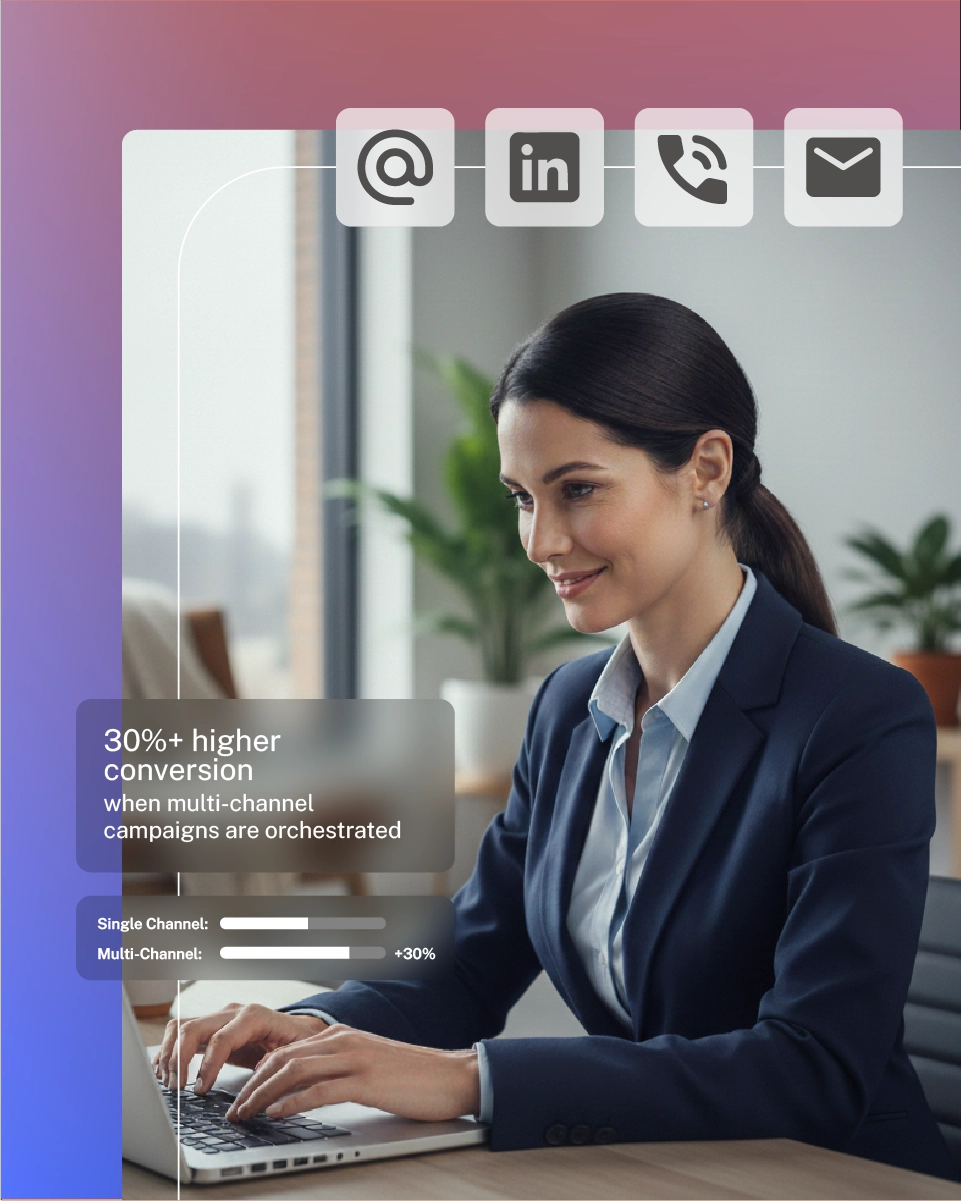

The Ultimate Guide to Closing Deals and Maximising Meeting Show Rates
[blog_at_glance]
Ever feel like you're crushing it on sales calls, only to fumble at the finish line? Or maybe you're booking meetings left and right, but your prospects are pulling vanishing acts worthy of Houdini? Don't worry, you're not alone. And more importantly, you're about to become a closing and show-rate superstar.
In this guide, we're going to walk you through the entire process - from smoothly transitioning to your close, to booking that meeting, and making sure your prospect actually shows up. Buckle up, because your sales game is about to level up.
Table of contents

The Link Technique
Picture this: You've just had an amazing chat with a CEO about their inventory issues. You're vibing, they're nodding, and then... you awkwardly mumble, "So... uh... wanna buy?" Ouch. We've all been there, and it sucks.
But what if I told you there's a smooth operator's way to glide from chat to close?
Enter: The Link.
A Link is your golden ticket to transition without sounding like a pushy car salesman. It's simple yet powerful. For example: "Sounds like these inventory issues are costing you big time. Let's set up a demo to show you how we can fix that."
Why should you care about Links? Because you're in sales to close deals, not make friends (though that's a nice bonus). Sales Hacker reports that reps using link techniques close 27% more deals. That's a lot of extra zeros on your paycheck.
Here's how to craft a Link that doesn't suck:
- Acknowledge what you've discussed.
- Suggest a next step that makes sense based on the conversation.
Try this: "Given the issues you mentioned with late deliveries, talking more with our logistics experts would really help." See how smooth that is?
The key is confidence. Use strong phrases like "it makes sense" or "it sounds like." Don't ask, "Would you maybe want to possibly meet again?" Instead, assert, "Let's schedule a follow-up to dive deeper into this."
Practice makes perfect. You might fumble at first, but keep at it. Soon, you'll be linking like a pro and closing deals left and right.

The Alternative Close
Ever tried to schedule a meeting and ended up in email ping-pong hell? What if you could book meetings faster than you can say "synergize our paradigms"?
Enter the alternative close.
Here's the deal: Instead of asking "When are you free?", hit 'em with "Does Tuesday at 2 PM or Thursday at 10 AM work better for you?" Boom. You've just made their life easier and your close rate higher.
Why does this work? It's all about brain science. Open-ended questions make brains go into overdrive. But give a couple options, and suddenly it's easier than choosing between Netflix or sleep.
Don't believe me? Try this:
- "Where do you want to go for dinner?" (Cue awkward silence and blank stares)
- "Italian or sushi?" (Watch how fast a decision is made)
That's the power of the alternative close in action. It works because:
- It narrows choices. No more decision paralysis.
- It prompts a simple response. No essays required.
- It gives you a clear endpoint. No more rambling.
But here's the kicker: Once you drop those options, keep your mouth shut. At Punch!, we call this "Shut the EFF up!" Let the silence do the heavy lifting.
For example:
You: "Based on our chat, it makes sense to dive deeper. Does tomorrow at 2 PM or Friday at 10 AM work better?"
Them: "Hmm... Let's do tomorrow at 2." You: "Perfect, I'll send an invite. Looking forward to it!"
Notice the lack of begging, justifying, or nervous chatter.

Closing Considerations
So, you've mastered link phrases and the alternative close. You're feeling like a sales Jedi, right? Well, hold onto your lightsaber, because we're about to level up your game even more.
Here are five closing considerations:
- Are you talking to the right person?
Make sure you're chatting with someone who can actually make decisions. You wouldn't ask the intern to approve a million-dollar deal, would you? Ask straight up, "Are you the one who makes decisions about [your solution]?" If not, find out who is and get them on the phone. - Dig for pain points
You're not a mind reader. Ask questions. Lots of them. Find out what keeps your prospect up at night. Is it missed deadlines? Shrinking budgets? The more you know about their problems, the better you can position your solution. - Keep your cool
Confidence is key. When closing, own it. Don't ask for a meeting like you're asking for a pity date to prom. State it like it's the obvious next step. Because it is.
Wrong: "Um, would you maybe want to possibly meet sometime?"
Right: "Based on what we've discussed, the next step is to schedule a deeper dive. How's Tuesday at 2?" - Objections are your friends
When a prospect objects, celebrate! Objections mean they're engaged. They're thinking about your offer. That's half the battle right there. Turn that objection into a reason to meet. - If at first you don't succeed, try again
Most sales aren't closed on the first try. Or the second. Or even the third. So keep at it. Be like a dog with a bone (a polite, professional dog, of course). Try closing up to three times in a call. Any more might make you sound desperate. But any less, and you're leaving money on the table.

Reduce No-Shows
You've nailed the call, linked to a close, and booked the meeting. But getting a "yes" is only half the battle. Now you've got to make sure they actually show up.
Here are 8 legendary tactics to make sure your prospect doesn't pull a Houdini:
- Qualify like a boss:
Don't just ask questions - dig deep. The more invested they are, the more likely they'll show. It's like dating - if they're not that into you, they'll probably ghost. - Strike while the iron's hot:
Book that meeting within 2-3 days. Any longer and they might forget why they were excited in the first place. - Reaffirm:
Before you hang up, confirm everything. Email, date, time, video or in-person. Then tell them you're sending a calendar invite. It's not nagging, it's being thorough. - Stay on the line:
After you send the invite, stay on the line until they accept it. It's like watching them sign the contract. No wiggle room for "Oh, I never got that invite." - Personalise that calendar invite:
After the call, jazz up that invite. Remind them of their pain points and how you're gonna solve them. Make it so enticing they can't wait for the meeting. - The 24-hour reminder call:
A day before, give 'em a ring. Remind them why they were excited. If needed, close again. It's not pushy, it's professional. - The email backup plan:
Can't reach 'em by phone? Send a quick email. Ask if there's anything else they want to cover. It's like leaving a trail of breadcrumbs to your meeting. - Coffee's on you:
If your client's got a gifting platform, send a coffee voucher.
Here's how it looks in action:
You: "Just confirming - Thursday, May 18th, 2pm BST, Zoom call. Your email is j.snider@company.com, right?"
Them: "Yep, that's right."
You: "Great, sending the invite now. Can you accept it while we're on the line?"
Them: "Sure... Done."
You: "Awesome. Anything else you want me to add to the agenda?"
Them: "Nope, we're good."
You: "Perfect. Looking forward to Thursday!"
See how smooth that was? No room for slip-ups or no-shows.
Conclusion
There you have it, sales warriors - your ultimate guide to closing deals and making sure those meetings actually happen. From the art of the Link to the science of the alternative close, from Jedi-level closing considerations to show-rate maximising tactics, you're now armed with everything you need to crush your targets.
Remember, in sales, the follow-through is just as important as the pitch. It's not just about getting the "yes" - it's about turning that "yes" into real, revenue-generating meetings.



“I focus on leading the direction of the business to maximise team efficiency and ensure client success”
[blog_at_glance]
Ever feel like you're crushing it on sales calls, only to fumble at the finish line? Or maybe you're booking meetings left and right, but your prospects are pulling vanishing acts worthy of Houdini? Don't worry, you're not alone. And more importantly, you're about to become a closing and show-rate superstar.
In this guide, we're going to walk you through the entire process - from smoothly transitioning to your close, to booking that meeting, and making sure your prospect actually shows up. Buckle up, because your sales game is about to level up.
Table of contents

The Link Technique
Picture this: You've just had an amazing chat with a CEO about their inventory issues. You're vibing, they're nodding, and then... you awkwardly mumble, "So... uh... wanna buy?" Ouch. We've all been there, and it sucks.
But what if I told you there's a smooth operator's way to glide from chat to close?
Enter: The Link.
A Link is your golden ticket to transition without sounding like a pushy car salesman. It's simple yet powerful. For example: "Sounds like these inventory issues are costing you big time. Let's set up a demo to show you how we can fix that."
Why should you care about Links? Because you're in sales to close deals, not make friends (though that's a nice bonus). Sales Hacker reports that reps using link techniques close 27% more deals. That's a lot of extra zeros on your paycheck.
Here's how to craft a Link that doesn't suck:
- Acknowledge what you've discussed.
- Suggest a next step that makes sense based on the conversation.
Try this: "Given the issues you mentioned with late deliveries, talking more with our logistics experts would really help." See how smooth that is?
The key is confidence. Use strong phrases like "it makes sense" or "it sounds like." Don't ask, "Would you maybe want to possibly meet again?" Instead, assert, "Let's schedule a follow-up to dive deeper into this."
Practice makes perfect. You might fumble at first, but keep at it. Soon, you'll be linking like a pro and closing deals left and right.

The Alternative Close
Ever tried to schedule a meeting and ended up in email ping-pong hell? What if you could book meetings faster than you can say "synergize our paradigms"?
Enter the alternative close.
Here's the deal: Instead of asking "When are you free?", hit 'em with "Does Tuesday at 2 PM or Thursday at 10 AM work better for you?" Boom. You've just made their life easier and your close rate higher.
Why does this work? It's all about brain science. Open-ended questions make brains go into overdrive. But give a couple options, and suddenly it's easier than choosing between Netflix or sleep.
Don't believe me? Try this:
- "Where do you want to go for dinner?" (Cue awkward silence and blank stares)
- "Italian or sushi?" (Watch how fast a decision is made)
That's the power of the alternative close in action. It works because:
- It narrows choices. No more decision paralysis.
- It prompts a simple response. No essays required.
- It gives you a clear endpoint. No more rambling.
But here's the kicker: Once you drop those options, keep your mouth shut. At Punch!, we call this "Shut the EFF up!" Let the silence do the heavy lifting.
For example:
You: "Based on our chat, it makes sense to dive deeper. Does tomorrow at 2 PM or Friday at 10 AM work better?"
Them: "Hmm... Let's do tomorrow at 2." You: "Perfect, I'll send an invite. Looking forward to it!"
Notice the lack of begging, justifying, or nervous chatter.

Closing Considerations
So, you've mastered link phrases and the alternative close. You're feeling like a sales Jedi, right? Well, hold onto your lightsaber, because we're about to level up your game even more.
Here are five closing considerations:
- Are you talking to the right person?
Make sure you're chatting with someone who can actually make decisions. You wouldn't ask the intern to approve a million-dollar deal, would you? Ask straight up, "Are you the one who makes decisions about [your solution]?" If not, find out who is and get them on the phone. - Dig for pain points
You're not a mind reader. Ask questions. Lots of them. Find out what keeps your prospect up at night. Is it missed deadlines? Shrinking budgets? The more you know about their problems, the better you can position your solution. - Keep your cool
Confidence is key. When closing, own it. Don't ask for a meeting like you're asking for a pity date to prom. State it like it's the obvious next step. Because it is.
Wrong: "Um, would you maybe want to possibly meet sometime?"
Right: "Based on what we've discussed, the next step is to schedule a deeper dive. How's Tuesday at 2?" - Objections are your friends
When a prospect objects, celebrate! Objections mean they're engaged. They're thinking about your offer. That's half the battle right there. Turn that objection into a reason to meet. - If at first you don't succeed, try again
Most sales aren't closed on the first try. Or the second. Or even the third. So keep at it. Be like a dog with a bone (a polite, professional dog, of course). Try closing up to three times in a call. Any more might make you sound desperate. But any less, and you're leaving money on the table.

Reduce No-Shows
You've nailed the call, linked to a close, and booked the meeting. But getting a "yes" is only half the battle. Now you've got to make sure they actually show up.
Here are 8 legendary tactics to make sure your prospect doesn't pull a Houdini:
- Qualify like a boss:
Don't just ask questions - dig deep. The more invested they are, the more likely they'll show. It's like dating - if they're not that into you, they'll probably ghost. - Strike while the iron's hot:
Book that meeting within 2-3 days. Any longer and they might forget why they were excited in the first place. - Reaffirm:
Before you hang up, confirm everything. Email, date, time, video or in-person. Then tell them you're sending a calendar invite. It's not nagging, it's being thorough. - Stay on the line:
After you send the invite, stay on the line until they accept it. It's like watching them sign the contract. No wiggle room for "Oh, I never got that invite." - Personalise that calendar invite:
After the call, jazz up that invite. Remind them of their pain points and how you're gonna solve them. Make it so enticing they can't wait for the meeting. - The 24-hour reminder call:
A day before, give 'em a ring. Remind them why they were excited. If needed, close again. It's not pushy, it's professional. - The email backup plan:
Can't reach 'em by phone? Send a quick email. Ask if there's anything else they want to cover. It's like leaving a trail of breadcrumbs to your meeting. - Coffee's on you:
If your client's got a gifting platform, send a coffee voucher.
Here's how it looks in action:
You: "Just confirming - Thursday, May 18th, 2pm BST, Zoom call. Your email is j.snider@company.com, right?"
Them: "Yep, that's right."
You: "Great, sending the invite now. Can you accept it while we're on the line?"
Them: "Sure... Done."
You: "Awesome. Anything else you want me to add to the agenda?"
Them: "Nope, we're good."
You: "Perfect. Looking forward to Thursday!"
See how smooth that was? No room for slip-ups or no-shows.
Conclusion
There you have it, sales warriors - your ultimate guide to closing deals and making sure those meetings actually happen. From the art of the Link to the science of the alternative close, from Jedi-level closing considerations to show-rate maximising tactics, you're now armed with everything you need to crush your targets.
Remember, in sales, the follow-through is just as important as the pitch. It's not just about getting the "yes" - it's about turning that "yes" into real, revenue-generating meetings.















